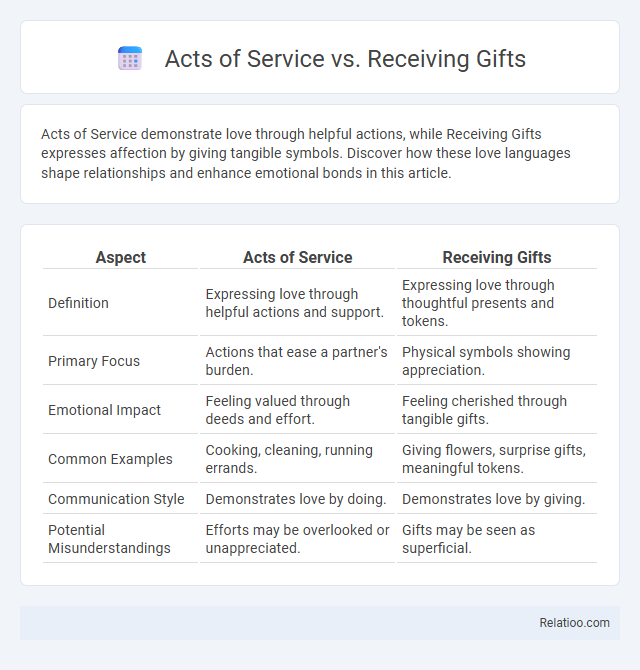Acts of Service demonstrate love through helpful actions, while Receiving Gifts expresses affection by giving tangible symbols. Discover how these love languages shape relationships and enhance emotional bonds in this article.
Table of Comparison
| Aspect | Acts of Service | Receiving Gifts |
|---|---|---|
| Definition | Expressing love through helpful actions and support. | Expressing love through thoughtful presents and tokens. |
| Primary Focus | Actions that ease a partner's burden. | Physical symbols showing appreciation. |
| Emotional Impact | Feeling valued through deeds and effort. | Feeling cherished through tangible gifts. |
| Common Examples | Cooking, cleaning, running errands. | Giving flowers, surprise gifts, meaningful tokens. |
| Communication Style | Demonstrates love by doing. | Demonstrates love by giving. |
| Potential Misunderstandings | Efforts may be overlooked or unappreciated. | Gifts may be seen as superficial. |
Understanding Love Languages: Acts of Service vs Receiving Gifts
Acts of Service and Receiving Gifts represent distinct love languages that communicate affection through actions and tangible expressions, respectively. Acts of Service involve performing helpful tasks to show care, such as cooking a meal or running errands, while Receiving Gifts centers on giving meaningful presents that symbolize thoughtfulness and appreciation. Recognizing whether a partner values Acts of Service or Receiving Gifts enhances emotional intimacy by aligning gestures with their preferred way of feeling loved.
Defining Acts of Service in Relationships
Acts of service in relationships involve expressing love through helpful actions, such as completing tasks or providing support, which demonstrates care and commitment. This love language contrasts with receiving gifts, which focuses on tangible symbols of affection, and emotional intimacy, which centers on sharing feelings and fostering deep personal connections. Understanding your partner's preference for acts of service can strengthen your relationship by ensuring your efforts match their emotional needs.
What Does Receiving Gifts Really Mean?
Receiving gifts signifies tangible expressions of love and appreciation, often reflecting thoughtfulness and consideration for the recipient's preferences. Unlike acts of service or emotional intimacy, gifts provide a physical symbol that can evoke lasting memories and reinforce relational bonds. This love language communicates value and care through carefully chosen items, making the recipient feel acknowledged and cherished.
The Psychological Impact of Acts of Service
Acts of Service profoundly influence your psychological well-being by fostering a sense of reliability and support within relationships, which helps reduce stress and enhance emotional security. Unlike Receiving Gifts, which primarily provide tangible reminders of affection, Acts of Service engage empathy and active care, promoting deeper emotional connections. Emotional intimacy grows stronger when partners consistently perform meaningful acts that demonstrate commitment, trust, and attentiveness to each other's needs.
Emotional Significance Behind Gift-Giving
Gift-giving carries deep emotional significance, serving as a tangible expression of affection, appreciation, and thoughtfulness that transcends mere material value. Unlike acts of service or emotional intimacy, gifts symbolize a concrete acknowledgment of the recipient's worth and are often memorably associated with milestones or personal sentiments. The intentional selection and presentation of gifts enhance emotional bonds by conveying care, understanding, and meaningful connection within relationships.
Comparing the Benefits: Service vs Gifts
Acts of Service provide tangible support by addressing practical needs, fostering trust and reliability in relationships, while Receiving Gifts offers symbolic expressions of affection that can create lasting memories and enhance emotional connections. Your choice between these love languages can influence relationship satisfaction, as Acts of Service tend to build stability through actions, whereas Gifts often communicate thoughtfulness and appreciation. Understanding these differences helps tailor meaningful gestures that resonate deeply and strengthen emotional intimacy.
Common Misunderstandings About Each Love Language
Acts of Service often get misunderstood as mere chores, yet they symbolize deep care and commitment rather than obligation. Receiving Gifts is sometimes mistaken for materialism, but it truly reflects thoughtfulness and the desire to make your partner feel valued. Emotional Intimacy is frequently confused with constant emotional disclosure, though it fundamentally means creating a safe space for genuine connection and vulnerability.
How to Identify Your Primary Love Language
Identifying Your Primary Love Language involves observing what resonates most deeply with your emotions and needs; if acts of service like helping with chores make you feel valued, that may be your top love language. You might find joy and connection when receiving thoughtful gifts, which symbolize appreciation and care tailored to your preferences. Recognizing whether you crave physical gestures of affection and open communication or tangible tokens of love helps you and your partner strengthen emotional intimacy effectively.
Strengthening Relationships: Practical Tips
Strengthening relationships relies on understanding and honoring your partner's preferred love languages, such as Acts of Service, Receiving Gifts, or Emotional Intimacy. You can deepen connection by offering thoughtful actions, meaningful presents, or genuine emotional presence tailored to their needs. Prioritize consistent communication and empathy to ensure these expressions resonate and foster lasting trust and closeness.
Choosing What Works Best for You and Your Partner
Choosing between Acts of Service, Receiving Gifts, and Emotional Intimacy depends on understanding your partner's core love language and emotional needs. Identifying which expressions resonate most deeply can enhance communication and strengthen your bond by fostering mutual appreciation and support. Personalized efforts aligned with each other's preferred love languages create a more fulfilling and harmonious relationship.

Infographic: Acts of Service vs Receiving Gifts
 relatioo.com
relatioo.com